
June 2001
Brahman is the eternal ocean of infinity from which all existence is manifest and into which all existence is dissolved. In the Upanisads, which are part of the ancient Indian Vedic texts, Brahman is described as unfathomable, limitless, attributeless, unchanging, and eternal. [1] Brahman, the Absolute, is beginningless, undying, omnipresent, and omnipotent. Brahman exists eternally in a state of pure undifferentiated energy. This ocean of the infinite spirit is incomprehensible to the mind because Brahman is eternally beyond definition. Brahman is the broadest sense of infinity. Any attempt to define the broadest sense creates an idea or thought which is finite and bounded by space and time. Brahman is the infinite and unbounded source of all things. All thoughts are reflections, or finite projections, of the infinite Absolute. Thus, Brahman is beyond existence, beyond mind, and beyond form.
It
is this conception of Brahman which unifies all the seemingly diverse
traditions of
There
are also other cultures in
From the perspective of Eastern philosophy, the Godhead is simultaneously formless and with form. If this seems paradoxical it is only because the Infinite Being, or the Personality of Godhead, transcends mundane human comprehension. All forms of existence are indeed moving images of the Godhead, and at the same time, the Godhead is eternally beyond all that exists. All that exists will be destroyed while the Infinite Being is primordial, unborn, and eternal. Paradoxically, the Godhead is not only everything and everywhere as well as nothing and nowhere, but indeed, the Godhead actually has a personality. The Infinite Being is both undifferentiated and differentiated, unmanifest and manifest, as well as without qualities and with qualities. Generally speaking, the Supreme is both transcendent and immanent. [3]
Throughout the history of Indian spiritual movements, the Saiva tradition is perhaps the most influential. Subtle forms of Saivism can be traced back more than five thousand years to the eariliest Vedic transmissions. However, the iconic imagery associated with Shiva is quite recent and developed around the third century A.D. In many ways, as we will see, Shiva is an ideal personification of the Absolute Brahman.
 |
 |
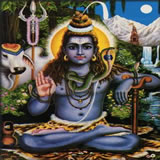 |
Several anthropomorphic interpretations of Shiva
Shiva encompasses all the paradoxes of the infinite and has both transcendent and immanent sides to his nature. By forming a relationship with Shiva’s immanent qualities, a faithful devotee is able to contact the Infinite Reality of Godhead in the transcendent form.
Generally speaking, Shiva is an interesting character because his personality transcends all physical, social, and spiritual boundaries. It is widely known that Shiva does not behave according to the ways of the world, and his appearance is most unconventional. Some might say that his wild habits are uncivilized and strange. For example, it is also well known that Shiva does not care to live in houses but prefers to live in caves, on mountains, or in forests, or to wander the world as a homeless beggar. He also spends much of his time dancing wildly in the cremation grounds. Indeed, many people refer to Shiva as the great unpredictable madman. [4]
Despite his uncouth ways, Shiva is the highest ascetic and is known as the Supreme Yogi (lakulisa). High on Mount Kailasha, his eternal abode, Shiva spends countless eons deep in meditation. At the same time, Shiva is known as an erotic lover, especially in the tradition of Shakti-Shiva which will be described later. This paradoxical connection between asceticism and eroticism is deeply rooted in the conception of Shiva. Besides being the Lord of Yogis, Shiva is also the Lord of Dancers (nataraja). He is also known as the God with the Moon in his Hair (candrasekhara), the Supporter of the Ganges (gangadhara), The Slayer of the Elephant-Demon (gajasamhara), The Lord Who is Half Woman (ardhanarisvara), and The Destroyer of Time (kalasamhara). [5] Before we take a deeper look at some of these immanent qualities, let us consider Shiva as The Great Lord (mahasamurti).
The Great Lord is represented by a three-headed figure of Shiva. This figure is also known as the Eternal Shiva. A stone carving depicting this image exists in the Great Cave of Shiva at Elephanta, which was created in the eighth century A.D. This amazing sculpture captures the process of creation and the nature of the Infinite Being in a very straightforward manner. The middle head represents the Absolute, the divine center. The head over the right shoulder is a male profile and represents the masculine aspect of existence. The head over the left shoulder is the profile of the feminine principle.
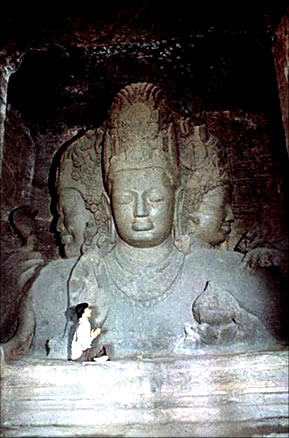
“The Essential Significance of Shiva’s Dance is threefold: First, it is the image of his Rhythmic Play as the Source of all Movement within the Cosmos, which is Represented by the Arch: Secondly, the Purpose of his Dance is to Release the Countless souls of men from the Snare of Illusion: Thirdly, the Place of the Dance, Chidambaram, the Center of the Universe, is within the Heart.” [9]
 |
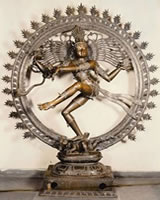 |
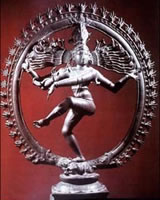 |
Shiva Lord of Dancers
Shiva is also represented with long dreadlocks which are flying in both directions as he dances. Many bronze Nataraja images include several symbolic images which are embedded in Shiva’s hair. For example, within his ascetic locks one can usually find a symbol representing the Goddess Ganga. This goddess is associated with Shiva because long ago she was as invoked by a man named Bhagiratha to descend to Earth in the form of a river in order to purify the ashes of Bhagiratha’s great-great grandfathers. His ancestors were destroyed by Lord Kapila and their ashes lay for generations at the bottom of a great empty ocean. Thus, they were unable to attain liberation unless their ashes were purified by the holy waters of the Ganges. However, Ganga is so powerful that if she were to descended to Earth, it could have destroyed the entire world. After many years of performing severe austerities, Bhagiratha invoked the presence of Shiva, whom agreed to bear the impact of the Ganges upon his head. [10] Thus Ganga was able to descend from Heaven in order to purify the Earth. Other ornaments in Shiva’s hair include a skull which is symbolic of death, and a crescent moon which represents illumination.
The image of the Dancing Lord immediately conveys the dynamic motion of reality and nature. However, in the midst of his furious dance of creation and dissolution, Shiva remains in a state of elegant serenity. Just as in the sculpture of the Eternal Shiva of Elephanta, his expression is undisturbed by the qualities of existence, for he is eternally absorbed in the Infinite Brahman. His attention is not directed outward, but inward, towards the inner Self (Atman) which resides deep in the heart of all things. The place where the Shiva’s dance is performed is known as Chidambaram, which refers to the heat of the individual and the heart of the Universe. “This is His Dance. Its deepest significance is felt when it is realized that it takes place within the heart and the self. Everywhere is God: that Everywhere is the heart.” [11] The Atman is the eternal soul which is never born, never suffers, and can never be destroyed. Atman and Brahman are one. Abiding in the eternal bliss of the all-knowing Self, Shiva’s dances creates the illusion of Maya, yet he is never distracted from the inner light of Brahman-Atman.
“His form is everywhere:
All-pervading in His Shiva-Shakti:
Chidambaram is everywhere, everywhere His dance:
As Shiva is all and omnipresent,
Everywhere is Shiva’s gracious dance made manifest.” [12]
Shiva’s dance represents the source of all existence (Brahman) dancing playfully with it’s Self (Atman). The figure embodies five major attributes of the Infinite Being: creation and evolution (sristi), preservation and support (sthiti), destruction (samhara), veiling and illusion (tirobhava), and release and grace (anugraha). The purpose of the dance is to release the souls of the illusioned by awakening the infinite spirit, which is the frequency of infinity. Shiva’s divine light penetrates the darkest realms of Maya. The source of this light is Chidambaram, within the Heart.
“Amid the flowers of His creation (prakriti), He lingers in a kiss.
Blinded by their beauty, He rushes, He frolics, He dances, He whirls.
He is all rapture, all bliss, in this play (lila).
In consciousness alone, in love alone,The Spirit learns the nature of His divine being.
Divinely playing in the multiplicity of forms, He comprehends Himself.” [13]
It is often difficult for some to understand this playful side of Shiva. Indeed, because Shiva is known primarily as The Destroyer, his presence is often terrible and horrific to those who do not recognize their own Self. Shiva’s dance creates the illusion of Maya which bewilders the ego-self and causes forgetfulness of the Absolute Truth. However, all existence is finite, and whatever has been displayed will be dissolved back into the divine essence of Brahman. At the end of each Universal Cycle, called the Mayayuga or the Great Eon, Shiva destroys all that has been created. However, his furious destruction of the Universe ultimately releases all souls into Brahman; thus, there is no reason to fear Shiva’s gruesome appearance as Death.
Indeed, Shiva is known as Yamantaka, which means The Destroyer of Death. Shiva ultimately conquers Yama, the God of Death. Shiva is Kala, which means Time. However, Shiva is also known as Maha-Kala, which means Great Time, Eternity, the swallower of time, and the swallower of all the ages and cycles of ages. Shiva is the destroyer of time (kalasamhara). [14]
Shiva is definitely characterized by his wild, unpredictable, destructive aspect. As the Lord of Dance, Nataraja, Shiva performs the tandava, which is the fierce, violent dance in which the Universe is destroyed. “In descriptions of this dance, Shiva’s whirling arms and flying locks crash into the heavenly bodies, knocking them off course or destroying them utterly.” [15] Through Shiva’s transcendental movements, everything is destroyed at the end of Time, only be re-born again at he beginning of the next Mahayuga. In addition to Shiva’s tandava dance, which is explosive and overwhelming, he also performs the lasya, which is a gentle dance full of emotions of tenderness and love. Shiva is the master of both the tandava and lasya forms of dance.
An essential key that can be used to unlock the mystery of Shiva lies in understanding that the Infinite Being represents the union of all polarities, which is why Shiva appears so paradoxical to the rational mind. The Infinite Being is infinitely small and infinitely large, everywhere and nowhere, good and evil, positive and negative, hot and cold, as well as violent and peaceful. We’ve already seen that the universe is the result of interacting polarities, such as the male and female heads of the Eternal Shiva. In the same context, the God and Goddess, yin and yang, are the first born manifestations of the Absolute. The Absolute is beyond the differentiating qualities of sex, and at the same time the Absolute is both male and female. In order to explore this idea, let’s consider the tradition of Shakti-Shiva.
In general, all male gods possess an inherent power with which they are able to express their creative energy. This power is known as shakti, and is always personified in the form of a goddess. Shakti not only represents the consort of a deity, but it represents the deity’s embodied power. In a less patriarchal sense, God and Goddess are equal and together they represent the Divine Couple. The male and female qualities of Godhead are unified by their transcendental love for each other, and together they are responsible for the creation of the all existence.
Shiva,
the Infinite Being, and Shakti, his consort, can be understood in terms of
the concepts of purusa (pure spirit) and prakrti (nature). In
this context, Shiva is the essence of Brahman and Shakti is the life
force which underlies and pervades the entire natural world. Although
Shiva and Shakti may appear as opposites, they are in essence one. One
cannot exist without the other. “Gazing with a deep and everlasting
rapture, they are imbued with the secret knowledge that, through seemingly
two, they are fundamentally one.” [16] Many
popular traditions in
The Universal power of Shakti is often identified with the Goddess Parvati, Shiva’s second wife. Shiva’s first wife was a goddess named Sati. Sati, it is said, committed suicide when her father, Daksa, insulted Shiva by not inviting him to a great sacrifice that was being performed. Parvati is generally considered to be the reincarnation of Sati. Parvati is a name which means “she who is of the mountains.” If Parvati is the earth, then Shiva is the sky. If Parvati is the light, then Shiva is the sun. If Parvati is the embodiment of all individual souls, then Shiva is the soul itself. Shiva and Parvati live on Mount Kailasha and spend much their time making love, which is so intense that it shakes the cosmos. [17]
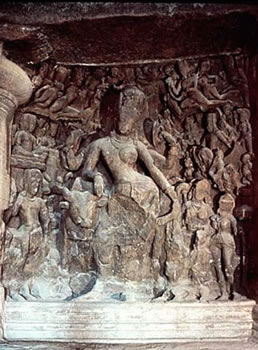 |
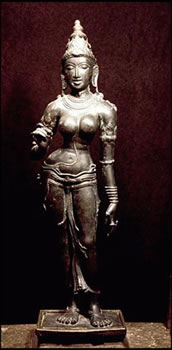 |
Androgynous Shiva |
Parvati |
A further illustration of the divine union between male and female is the Ardhanarisvara image which is an androgynous figure of Shiva and Parvati. This image is usually depicted by a sculpture that is half-male and half-female. The Ardhanarisvara emphasizes the interdependency of the two complimentary aspects of the divine. Only in union can they satisfy each other and fulfill themselves. The Godhead is male and female, father and mother, aloof and active, as well as destructive and constructive. In his androgynous form, Shiva represents the union of all existing polarities.
Up to this point, we have looked only at the anthropomorphic, or immanent, representations of Shiva. Each particular image effectively represents the paradoxical, transcendent qualities of the Absolute Brahman. However, they are only images that humans have created to facilitate the comprehension of that which is inherently indefinable. The immanent, or iconic, forms of Shiva represent the various forms and metaphors of the Infinite Being that have developed in the eyes and minds of worshipers over thousands and thousands of years. However, all these ideas are limited by space and time. For example, we create human versions of the Absolute because we are human. If we were any other different species, say from somewhere else in the Universe, we would probably use a completely different set of visual images and metaphors to relate to the Absolute, which is the Infinite Source of all existence, no matter what galaxy you’re from.
For this reason, the most common and widely accepted form of worship in the Saiva tradition focuses on an object which transcends the iconic image of Shiva. This object is the linga. The linga, unlike the images discussed earlier, is aniconic. The word linga can mean “mark”, “sign”, or “phallus”, and it is usually represented by a small egg-shaped stone or a stone cylinder with a rounded top. [18] This form of Shiva is referred to as “fixed” or “immovable” (dhruva). The linga is also considered to be “the fundamental form” (mulavigraha) of Shiva. In contrast, all the anthropomorphic images discussed so far are considered “movable” (cala). [19]
The linga itself is simple and straightforward. It is completely undifferentiated and thus reflects the every-thing and no-thing that is Brahman. The linga directly represents the transcendent aspect of Godhead which is eternally beyond form or description. Often, the perimeter of temples and shrines that dedicated to Shiva are lined with immanent manifestations of Shiva depicting various epic scenes that correspond to mythology. However, in the center of the temple, or inner shrine, Shiva is worshipped in the form of the linga.
The cave temple of Elephanta (6th century) and the rock-cut temple of Ellura (8th century) are perfect examples. In the temple of Elephanta, the walls and doorways are decorated with illustrations which depict Shiva’s anthropomorphic manifestations. Among these are images of Shiva the Lord of Yogis, Shiva the Lord of Dancers, the Eternal Shiva, Shiva the vanquisher of the elephant-demon Andhaka, the Decent of the Ganges, the Marriage of Shiva and Parvati, and the Androgynous Lord as Half-Woman. However, the central sanctuary of the temple is a simple, square shrine, with four entrances, each guarded by a pair of divine door keepers. Within the inner sanctum is the symbol of the linga.
The Shiva linga often resembles an egg-shaped stone. The use of this small “Cosmic Egg” is probably the most ancient form of Saiva worship. There are also lingas in the form of a cylinder with a rounded top. In this form, the linga is often interpreted as a fiery column of light, or lightning (vajra, keraunos) The pillar of light can also be interpreted as the Axis Mundi, which connects the physical and spiritual dimensions of existence. [20] The cylinder shaped linga is also a symbol of the male creative energy, thus it has also been interpreted as a phallic image. The earliest phallic linga is the Gudimallam linga which dates back to 100 B.C. [21]
The male energy of the linga is often combined with the female energy, which is represented by the yoni or pitha. In many cases the vertical shaft of the linga is depicted emerging from a circular base, which forms the yoni. This image symbolizes the antagonistic yet cooperative forces of male and female, Shiva and Shakti, transcendent and immanent, as well as spirit (purusa) and nature (prakrti). The image of the linga and yoni is the simplest representation of the Divine Couple as Godhead.

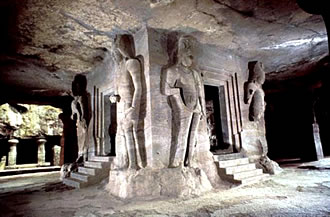
Inside the cave of Elephanta
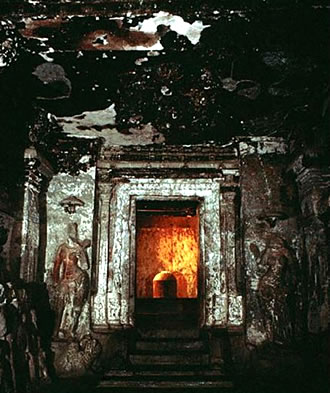
Shiva linga within inner shrine at Elephanta
Many forms of worship are offered to the Shiva linga such as sprinkling the stone with water, offerings of flowers, food, cloth, and incense. Also, the linga is often anointed by smearing the stone with various substances such as vermilion paint or dry red kunkum powder.
All representations of Shiva, iconic and aniconic alike, require the invocation of the divine presence. If these forms are actually going to be used to contact the essence of Godhead, the worshiper must animate the image of Shiva through ritual procedures. Images used in temples undergo special rites of consecration. For example, before the image is even created, the artist performs a ritual purification and prays to the deity that is to be embodied. Once the image has been completed, it is purified with a variety of substances, such as darbha grass, ghee, and honey. Then, in a ritual known as pranapratistha, the breath of life (prana) is evoked into the image. This is usually done by chanting a mantra which brings the inner presence of God into focus. Finally, the eyes of the image are opened by a brahmin priest using a golden needle. [22] The consecrated images of deities appear in temples dressed in silk clothing and decorated with necklaces, bracelets, belts, and rings. Offerings usually include incense, flowers, and plates of coconut, bananas, and rice.
Clay images are often used during special puja celebrations and festivals. These festival images are often taken into the home and worshipped or taken on procession through the town. In either case, the image is treated as if it were the living form of the deity. Once the image has been consecrated, there is no difference between the physical form and the presence of the deity that is being worshipped. After the festival is over, the image is usually taken to a river or ocean and submerged into the waters. The image of the deity dissolves and the divine presence is released from material embodiment.
The image of the deity is a specific embodiment (murti) of divine energy. All things are specific manifestations of the Infinite Spirit. In general, murti refers to anything which has a definite shape and limits. The embodiment, maintenance, and dissolution of the consecrated image obviously reflects the experience of all living entities which are created by the Source, maintained for some finite period of time, and then destroyed, at which point the soul (Atman) returns to the Infinite ocean of undifferentiated divine consciousness (Brahman).
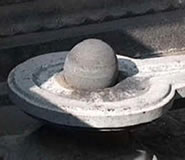 |
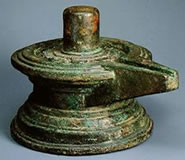 |
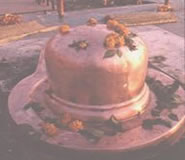 |
 |
More examples of the Shiva linga
“The fabricated image is a body (vigraha) or embodiment (murti). Divinity in the form of a soul (Atman), animating spirit (jiva), life breath (prana), consciousness (cetana), or divine energy (shakti) must enter this body to bring it to life, to infuse it with divine presence, just as a soul must enter a human body to instill life into it.” [23]
An important point to remember is this: even through the Atman had become identified with material nature, due to the effects of Maya, at no time is the embodied manifestation separate from Brahman. “The murti is a body-taking manifestation, and is not different from the reality itself.” [24] The Absolute is the Source of all forms, the Absolute is not different from the forms that it assumes, and at the same time, the Absolute is eternally beyond form. According to the Bhagavata tradition, there are five forms of the Lord.
“The five are the Supreme form (para), the emanations or powers of the Supreme (vyuha), the immanence of the Supreme in the heart of the individual and in the heart of the universe (antaryamin), the incarnations of the Supreme (vibhava), and the presence of the Supreme Lord in a properly consecrated image (arca).” [25] The bottom line is that any thing that exists is a manifestation of the Infinite Being, and thus, any form of object can be used to represent the essence of God. However, it is impossible for any image to ever capture the pure essence of Brahman because the Absolute is eternally beyond any form of definition. In many ways, the manifest image of Shiva allows humans to visualize and approach the Supreme Being, which otherwise remains incomprehensible and inaccessible.
Shiva is perhaps the ideal personification of the Infinite Being because he is closely related to the act of destruction. However, this destruction is not be feared. The presence and knowledge of Shiva destroys the illusion of suffering and false-ego. All things are destined to be dissolved into Shiva’s fire. However, this fire only burns away the prison if ignorance. The Atman is eternal and indestructible; thus, Shiva’s fire represents the awakening of the soul to its true nature, or Higher Self, which is none other than the Infinite Being.
To obtain liberation (moksa) is to awaken from the illusion of selfish desires and material attachments. The material world is called Maya because it is only a temporary mirage or reflection of the Infinite Being, which is eternal. The Personality of Godhead is the source of all existence, which lives deep inside each and every heart. Each specific part of existence essentially contains the whole. Yet, at the same time, the whole is greater than the sum of its parts. Everything comes from the Godhead, and the Godhead is everything.
Throughout the history of Indian spiritual movements, there have been many schools of thought concerning the most effective way in which the Godhead can be reached. One such school of thought is founded on the commentaries of an eighteenth century philosopher named Sankara. His philosophy is generally known as Advaita Vedanta. Sankara emphasized that image worship is an inferior mode of religious practice. Although some worshipers may only be able to approach divinity in the form of an embodied physical image, he considered this form of worship to be on a lower level then direct unmediated realization of oneness with the transcendent Brahman. Sankara also emphasized that Brahman is formless and without qualities (nirguna). [26] The Advaita Vedanta conception of Brahman is formless and impersonal. However, one can not ‘know’ God if one is focusing only on the impersonal aspect of Brahman.
Many
spiritual traditions of
“It is explained in the Gita that impersonal Brahman is subordinate to the complete Supreme Person. Brahman is more explicitly explained in the Brahmasutra to be like the rays of sunshine. The impersonal Brahman is the shining rays of the Supreme Personality of Godhead. Impersonal Brahman is incomplete realization of the absolute whole.” [27]
Those who have realized the limited realization of an impersonal Brahman have also realized that the true experience of Godhead is not something that can be commanded by the individual living entity. In the bhakti schools of spirituality, devotional service to a personal Godhead is considered far superior than an intellectual or philosophical relationship with an impersonal Brahman. For true devotees, the Supreme Personality of Godhead is the focus of every thought and every activity.
“All true experience of God is krpa, grace that cannot be called, recalled, or commanded. The vacanas distinguish experience and the Experience. Living in history, time and cliche, one lives in a world of the pre-established, through the received and the remembered. But the Experience when it comes, comes like a storm to all such husks and labels.” [28]
The true presence of Shiva, the Infinite Being, is accessible to those who are able to release themselves into the present moment, those who surrender all forms of finite attachments, and those who cultivate a personal relationship of devotional service to the Supreme Being. In whatever way the devotee approaches the Personality of Godhead, in that way the Godhead reveals Himself through transcendental grace and infinite love.
“Impersonalists argue that the Supreme Lord ultimately has no form. Persons who are under the impression that the Absolute Truth is impersonal are described as abuddhayah, which means those who do not know the ultimate feature of the Absolute Truth. Only by the mercy of the Supreme Lord can the Personality of the Supreme be known. My lord, if one is favored by even a slight trace of the mercy of Your lotus feet, he can understand the greatness of Your personality. But those who speculate to understand the Supreme Personality of Godhead are unable to know You, even if they continue to study the Vedas for many years. One cannot understand the Supreme Personality of Godhead, or His form, quality or name simply by mental speculation or by discussing Vedic literature. One must understand Him by devotional service.” [29]
Throughout this exploration into the depths of transcendental wisdom we have encountered many conceptions of Shiva, the Infinite Being. Shiva represents the Godhead which is the Original Source as well as the Destroyer of all existence. Shiva is the essence of the Infinite Brahman. Brahman is incomprehensible to the rational intellect because the transcendental Absolute is eternally beyond any form of definition. The essence of Shiva is often conveyed through the use of metaphorical images which are designed to resonate with the subconscious intuition of living entities which are currently existing as finite projections of Infinite Source. However, the Infinite Source is actually within the heart of each living entity. The illusion of Maya, which is created through identification of the Atman with material nature, causes forgetfulness of one’s eternal connection to the Source of All that Is. The only way out of this illusion is to realize the broadest sense, which is that everything comes from and returns to the One Source. This Source is the divine consciousness of the Infinite Being. The only way to truly contact this Reality is through the grace of the Infinite Being, which is given freely to those who are engaged in loving devotional service to the Supreme Personality of the Godhead.
Sources
Bhakta, Amal. Mahabharata. Torchlight Publishing. 2000.
Davis, Richard H. Lives of Indian Images. Princeton University Press. New Jersey. (class reader)
Eck, Diana L. Darson: Seeing the Divine Image in
Kaimal, Padma. Shiva Nataraja: Shifting Meanings of an Icon. (class reader)
Kinsley, David R. Hindu Goddesses. University of California Press. 1988.
Prabhupada, A.C. Bhaktivedanta. Bhadavad-Gita: As It Is. The Bhaktivedanta Book Trust. 1986.
Ramanujan, A.K. Speaking of Siva. Penguin. (class reader)
The Dance of Shiva. (class reader)
Zimmer, Heinrich. Myths and Symbols in Indian Art and Civilization. Princeton University Press. 1992.

[1] Davis, Richard H. Lives of Indian Images. p. 27
[2] Eck, Diana L, Darsan, seeing the divine image
in
[3] Davis, Richard H. Lives of Indian Images. p. 27
[4] Kinsley, David R. Hindu Goddesses. p. 46
[5] Zimmer, Heinrich. Myths and Symbols in Indian Art and Civilization. p. 126
[6] Ibid. p. 148
[7] Kaimal, Padma. Shiva Nataraja: Shifting Meanings of an Icon. p. 391
[8] Eck, Diana L. Darsan: Seeing the Divine Image in
[9] The Dance of Shiva. p. 244
[10] Bhakta, Amal. Mahabharata. p. 209
[11] The Dance of Shiva. p. 242
[12] Ibid. p. 241
[13] Ibid. p. 243
[14] Zimmer, Heinrich. Myths and Symbols in Indian Art and Civilization. p. 167
[15] Kinsley, David R. Hindu Goddesses. p. 47
[16] Zimmer, Heinrich. Myths and Symbols in Indian Art and Civilization. p. 137
[17] Kinsley, David R. Hindu Goddesses. p. 37 - 43
[18] Eck, Diana L. Darsan: Seeing the
Divine Image in
[19] Zimmer, Heinrich. Myths and Symbols in Indian Art and Civilization. p. 126-7
[20] Ibid. p. 128
[21] Eck, Diana L. Darsan: Seeing the
Divine Image in
[22] Ibid. p. 52-3
[23] Davis, Richard H. Lives of Indian Images. p. 34
[24] Eck, Diana L. Darsan: Seeing the
Divine Image in
[25] Eck, Diana L. Darsan: Seeing the
Divine Image in
[26] Davis, Richard H. Lives of Indian Images. p. 47
[27] Prabhupada, A. C. Bhaktivedanta. Bhagavad-Gita: As It Is.” p. 14
[28] A.K. Ramanujan. Speaking of Shiva. p. 31
[29] Prabhupada, A. C. Bhaktivedanta. Bhagavad-Gita: As It Is." p.401-2